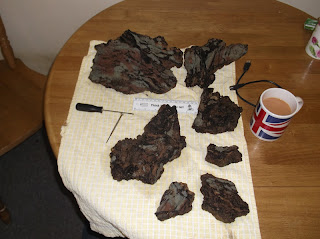These Artifacts were the first i found at Stainton beck, and were just down stream from were i have recently excavated Human skull fragments and a tibia shaft, from over 2 metres into the packed gravel beds.
This Artifact was found in Stainton beck by myself 5 years ago, it has been described by Professionals from Durham University as firstly a possible ice skate! then a water worn piece of medieval cow bone and last but not least a regurgitated piece of bone a cow swallowed. this idea was from the main man Andy Currant of the National history museum.
The Artifact shown above and below had two equal tines when found, one was broken and lost.
The pieces below i believe are utilised animal leg bones ( Digging sticks ) one is a horse tibia, the other some type of bovine radius. These two items were also viewed by people at Durham university on a few occasions, and each time refered too as being split for marrow nothing more.
All these items where found in a very small section of Stainton beck not long after flooding, and just down stream from an exposure of the Stainton gravel beds.


















































